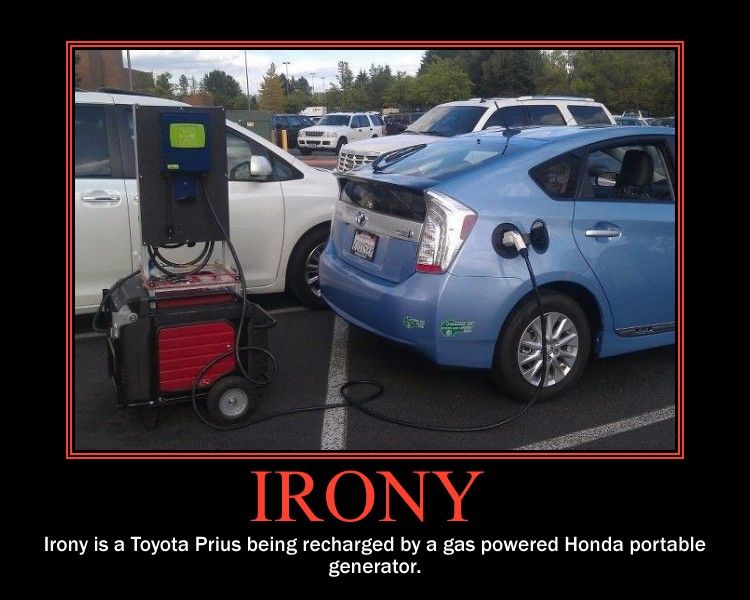Back in the early 2000s, we bought a golf cart to use at Camp Freehold. When faced with the choice between gas or electric, I came firmly down on the side of electric. At that time I was still able to golf, and while my preference was walking the course, some of my partners weren’t able to handle it for various reasons. I saw plenty of electric carts getting towed back to the club house, while a gas cart got a gasoline delivery.
You can’t carry a gallon of electricity to your dry electric golf cart. I suppose you could take a generator and a battery charger, but that’s just…meme territory.

These days, with the minor proliferation of electric cars, they call it “range anxiety”.
Uh-huh.
Mrs. Freeholder has driven a Toyota Camry Hybrid for 5-ish years. It’s not a bad car. The hybrid system only serves to overcome the initial inertia at start plus a very limited amount of slow speed movement in a driveway or parking lot. The rest of the time, the 4 cyl gas engine moves the car. While I think it’s needless added complexity that will never pay for itself, when you get the car used for a screaming deal, it’s OK. And it does get something like 42 MPG on the highway, motivating you along in vanilla comfort.
But that car can’t leave you stranded even if the battery dies. The e-e-evil fossil fuel engine will keep you going until you can replace that dead battery with a $2000+ rebuilt battery pack (or a $5000+ new one). Either way, you haven’t saved enough in gas to pay for the battery.
Imagine my lulz when I read this this morning. Ars Technica has some pretty definite green tendencies, so this has got to be a rude awakening.
Physics is a bitch, folks, but you can’t outwit it.
The article is just precious, as we try to figure out how to sugar-coat the bad news:
- “We’re used to seeing higher EPA mileage estimates with highway driving, but the opposite is true for BEVs: the faster you go, the quicker you’ll drain the battery.”
- “A 69-mile drive used up just over a third of the available range, leaving me with a nagging feeling that I should plug it in.”
- “You’ll notice that I gained 34 miles of range from around four hours of charging on a relatively balmy 34° Chicago day.”
I’ll stop there. That’s just from the first 3 days of winter driving in a $70,000 automobile. IT gets better as it goes along, RTWT.
It’s another post, but we’ve just bought Mrs. Freeholder a new vehicle. For around 1/3rd the price, I can get what I’m guessing will be around 3-4x the range, and I can refuel from empty to full in 5 minutes in most any small town I’ve ever seen, and a lot of wide spots on the road. Try that with your electric vehicle.
Son wants the Toyota. His muscle car is eating more than he’d like on the work commute. It’ll be great for his need, at least until that battery goes.
Being it’s cold outside, I’m going to stay inside and bask in the warmth of my schadenfreude.



The most ironic image I have seen was a car recharging station in a rural area and in the background was a diesel generator.
Here is my comprehensive list of what it will take for me to EVER own an electric vehicle. There is NO COMPROMISE on any of these points:
1). The vehicle must be nothing less than a full-size 4-door cab 4×4 pickup truck
2). It must be able to carry the load and have a matching towing capacity of such a conventional truck, without being diminished because of battery weight or passenger capacity.
3). It must have the cruising range of a V-8 powered truck with at least a 26 gallon fuel tank, and at best dual fuel tanks.
4). Charging stations are as available and numerous as gas stations
5). A full charge should take no more time than it takes to fill a conventional fuel tank(s)
6). Batteries must last as long as a gasoline engine before needing full replacement. An example; I just traded in my wife's 2005 Toyota 4Runner with 268,226 miles on it. It still had the original unmolested engine. Spark plugs, batteries, filters and oil changes only.
7). The vehicle MSRP is comparable to a fuel powered vehicle, and does not require a government subsidy in order to purchase.
8). Battery technology must be advanced enough to be environmentally friendly; both in production and for recycling. Batteries should also be safe enough to prevent thermal runaway and spontaneous fires.
After reading my list, I sure you will agree, I will never one or drive one.